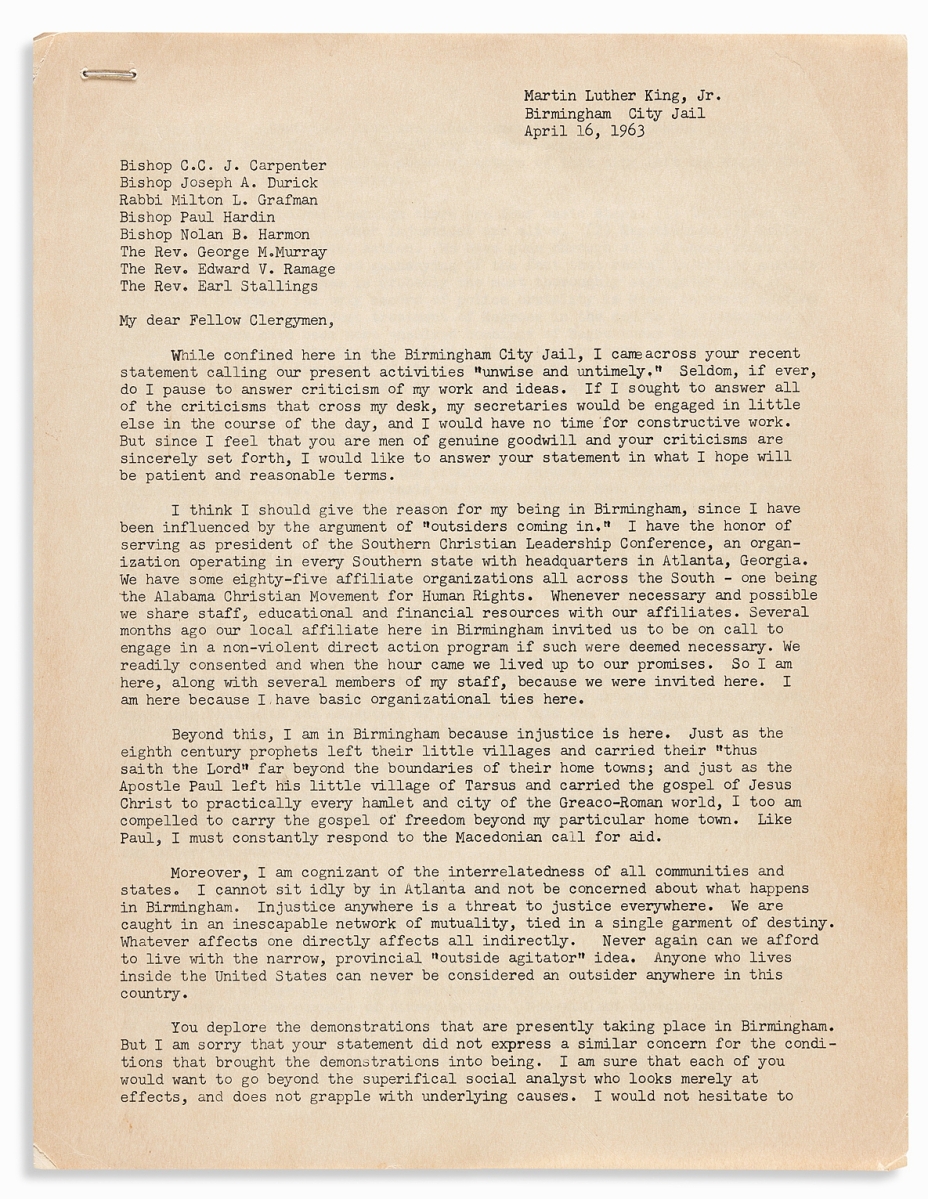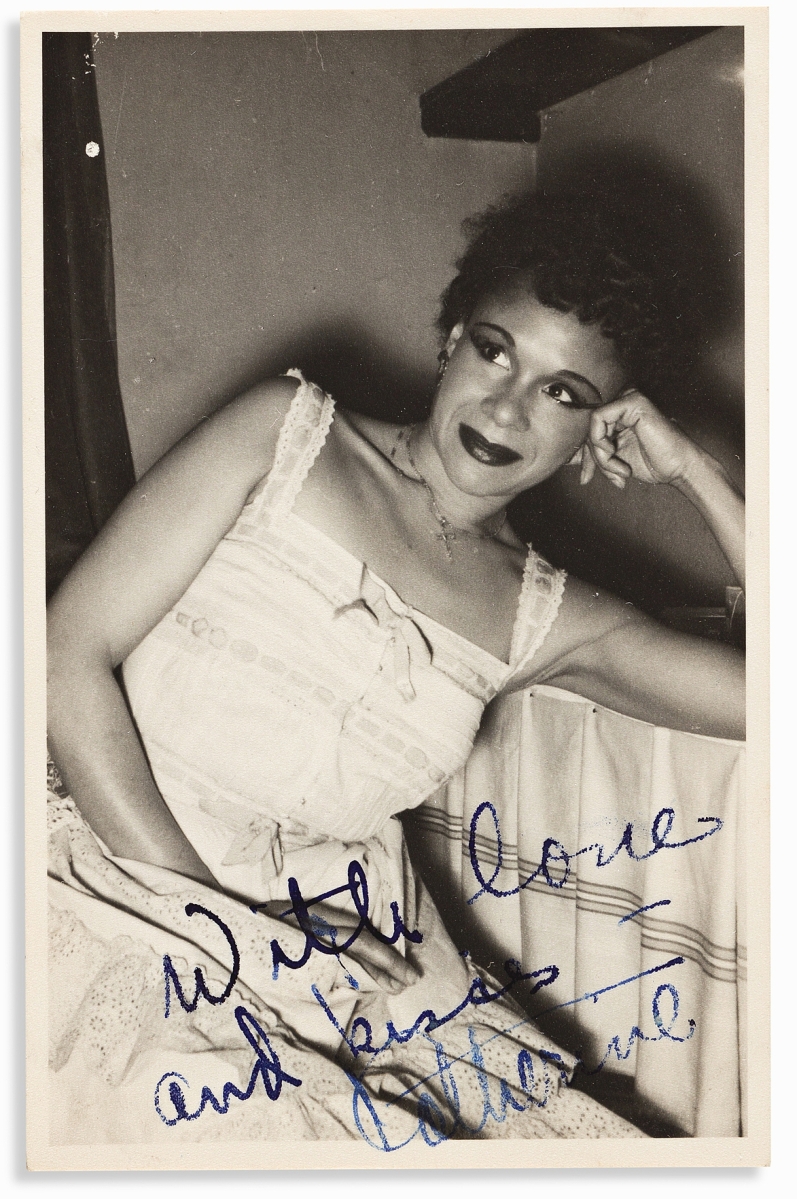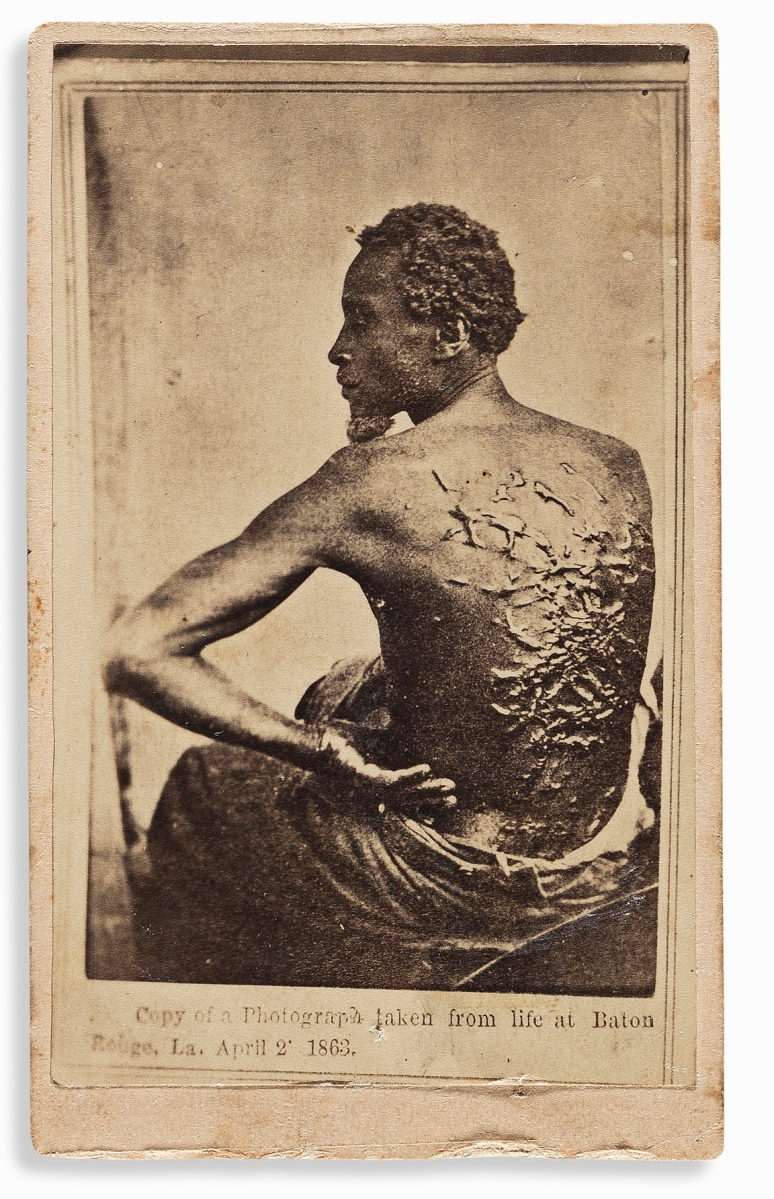
By far the highest priced item in the sale was a pre-publication draft of Martin Luther King’s “Birmingham Jail Letter,” which sold for $185,000. King wrote the letter, which urged non-violent civil disobedience, while in the Birmingham jail in 1963. He had been arrested along with other leaders of the Southern Christian Leadership Conference during a peaceful demonstration but remained in jail for eight days.
Review by Rick Russack, Photos Courtesy Swann Galleries
NEW YORK CITY – Since the late 1990s, Swann Galleries has conducted an annual sale fully devoted to African American material on paper. It’s believed to be the only auction house in the United States that does so. The field is broad, with items dating back to before the Revolutionary War and encompassing Nineteenth Century abolition and slavery items, such as slave narratives, printed abolitionist tracts, reward posters for the capture of runaway slaves, photographs, books written by ex-slaves and more.
On March 25, there was a wide selection of Nineteenth and Twentieth Century literature written by Black writers and leaders, and there were numerous manuscript items. Material relating to the Civil Rights and protest movements of the 1960s, a broad category, included Black Panther items, Malcom X materials, photographs relating to desegregation and marches, Angela Davis and other Black protest items. There was artwork by Black artists and works picturing leading African Americans, material relating to Black-owned and -operated businesses, material relating to Black entertainers, and still more.
Prior to the sale, Rick Stattler Swann’s director of printed and manuscript Americana, was asked what effect the current equality issues and Black Lives Matter movements might have on this sale. His comment: “We don’t know. This is our first sale with these movements so much in the national consciousness. We don’t know how, if at all, this sale will be affected. We do know that interest has been strong in previous years and continues to get stronger. We’re seeing many new buyers, so we’ll better be able to answer that question after the sale.” While one auction cannot accurately predict what the future will be, nor say that a trend exists, the numbers for this sale are impressive. The gross exceeded the high estimate by more than 60 percent – $1,075,000 against a high catalog estimate of $620,000. The gross for this sale was about 35 percent higher than last year’s African American sale. A total of 88 percent of the items were sold, and that number continues to increase with post-sale buying. More than 15 items sold for five figures.

A total of $52,500, the second highest price of the sale, was paid for about 85 items relating to modern dance star Katherine Dunham. The lot included numerous photographs and, of most interest, a 42-page diary she kept while in Tokyo in 1958. A second lot composed of her letters to a close friend brought $35,000. Taken together, the selling prices were nearly six times above their combined estimates.
After the sale, Stattler said, “We had a lot of new buyers, and there was very strong interest in categories such as women’s history and Black literature. Five of the top ten selling items went to private collectors, including the King letter, and three went to institutions adding to their collections. I think that’s a good indication of the direction the market is taking.” Swann’s cataloging both described the condition of the item, and in most cases, included a substantial amount of background information, explaining the context in which it originally appeared, or has come to be realized today. Authenticity is guaranteed.
The highest priced item in the sale, selling for more than $100,000 over the next highest item, was an important Martin Luther King letter. The letter, a possibly unique prepublication draft of the well-known “Birmingham Jail Letter,” sold for $185,000. On April 12, 1963, King and other leaders of the Southern Christian Leadership Conference were arrested following non-violent demonstrations in Birmingham, Ala. In the letter, responding to local white clergymen’s call for demonstrators to seek redress through the courts, King made the case for civil disobedience in the face of unjust laws. King was in the Birmingham jail for eight days following his arrest and wrote this letter on scraps of paper smuggled to him by a prison guard. Swann’s detailed catalog description discusses what is known of the history of the document. “The letter, which went through several revisions, was distributed locally to churches before making its first partial print appearance on 19 May 1963. From there, it appeared in hundreds of different publications – books, newspapers, magazines and in pamphlet form, often with subtle textual variations.” Although King’s original manuscript has long since disappeared, several early drafts of the “Letter from Birmingham Jail” have been traced by the Stanford University’s King Papers Project. No other examples of the present draft have been found. In a March 9 sale at Hake’s, a related item, a Birmingham jailhouse correspondence logbook, featuring 12 Martin Luther King Jr signatures, sold for more than $130,000 to a private collector.
Swann’s catalog further discusses the importance of this letter. It states that the “textual history of the letter has been discussed in several books on King. This 11-page draft is in single-spaced format and electrostatically duplicated, while most other pre-publication typed drafts are 19 to 22 pages in length, double-spaced and mimeographed. It generally follows the earliest known complete drafts but differs in dozens of places from most standard published versions, and also in places from the other known early drafts – in both text and formatting.” The letter was sold to a private collector.

Only two other complete runs of Black Opals, a short-lived literary magazine, are known to exist. Tied closely to the Harlem Renaissance, the magazine, subtitled “Hail Negro Youth,” featured works by leading “New Negro” authors. The four issues sold for $45,000, far above the estimate.
There were about a dozen other King items offered, including photographs and printed material. A reel-to-reel tape recording of a speech King delivered to the board and staff of the Southern Christian Leadership Conference in January 1968 brought $16,250. In it, King discusses plans for the “Poor People’s Campaign,” which turned out to be his last campaign, started shortly before his assassination. His aim was to bring the issues of Black struggles to Washington, again advocating the power of non-violent demonstrations.
Items featuring Black entertainers were popular. Selling for $52,000, the second highest price of the day, was a group of material relating to Katherine Dunham (1909-2006), one of the most important American dancers of the Twentieth Century. She led her own dance company and ran her own school of dance in New York. A graduate of the University of Chicago, she was an anthropologist and scholar of dance in addition to her career on stage, and the author of three books. She toured widely across several continents, and this lot, with photographs and correspondence, included a 42-page personal diary, mostly from time she spent during 1958 while in Tokyo writing her memoir. A second lot, with a large group of letters mostly written to her assistant and friend, Dorothy Gray, realized $35,000. The letters spanned the years 1946-62, written from all over the world, and the lot included some other items. Taken together, the two lots earned $87,000. From the catalog: “These letters put Dunham’s personality on vivid display: razor-sharp intelligence, deep and genuine concern for her friends, commitment to her art and a flair for the dramatic. Her letters are almost uniformly entertaining. We know of no other Dunham archives that have appeared at auction, and yet here are two unrelated lots from different consignors in the same sale.”
Other music-related items included an original maquette for a 1982 Cultural Freebee Jam flyer, which included the printed flyer for the Kool Lance hip-hop performance. It earned $7,500, and a poster for another hip-hop show, featuring Run DMC, reached $6,500. A poster for a 1968 Nina Simone concert earned $3,750. An inscribed photo of Duke Ellington brought $720, and a photo signed by Louis Armstrong and Earl Hines brought $406.

Selling for $21,250 was a second-generation CDV of one of the most iconic images of slavery. After repeated beating and whippings at a Louisiana plantation, Gordon escaped from slavery and made his way to a Union army camp at Baton Rouge, where he joined the Army as a private. A camp photographer took a series of photographs, of which this became the best known. It appeared in a July 1863 issue of Harper’s Weekly.
The literature category turned in strong results, with many items selling substantially above estimates. A complete run of Philadelphia’s short-lived but influential literary magazine, Black Opals, closely tied to the Harlem Renaissance, sold for $45,000, far above the estimate. The magazine, subtitled “Hail Negro Youth,” featured work by leading “New Negro” authors including Alain Locke, Jessie Redmon Fauset and Langston Hughes. Only two libraries own complete runs of this publication. The first book by an African American author, Phillis Wheatley, published in London in 1773, Poems on Various Subjects, Religious and Moral, realized $26,250. She was freed by her owner shortly after the book was published. Her poetry came to the attention of George Washington, Thomas Paine, John Paul Jones and Thomas Jefferson, but she nonetheless worked as a scullery maid to pay her bills and died in poverty at the age of 31. Famous American Negros by Langston Hughes, published in 1954, reached $1,000. It was an inscribed copy, in an original dust jacket. As it turned out, one of the highest priced items in the sale was also one of the earliest. Realizing $42,500 was Banneker’s Almanack, and Ephemeris for the Year of our Lord, 1793, with only 44 of 48 pages. Black scientist and surveyor Benjamin Banneker (1731-1806) is best known today for the annual almanacs he published from 1791 through 1796. This was his second almanac.
Prices given include the buyer’s premium as stated by the auction house. For more information, www.swanngalleries.com or 212-254-4710.




























